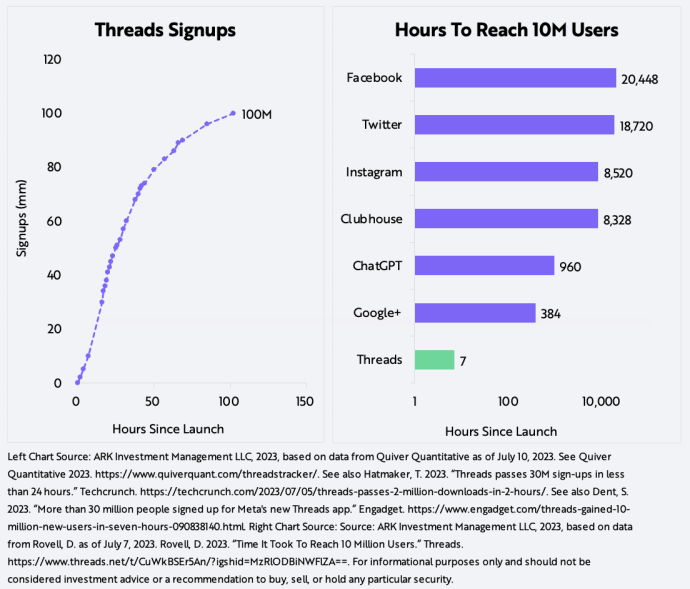#374: Meta’s Threadt?, & More
1. Meta’s Threadt?

Last Wednesday, Meta launched[1] Threads, a text-based social media app integrated with Instagram. Users create a new Threads account via their existing Instagram accounts, enabling seamless, authenticated onboarding for Instagram’s 2+ billion[2] monthly active users. Threads allows users to post texts up to 500 characters, in addition to links, photos, and videos up to five minutes long. While the app’s first version of feeds is not chronological and does not include a search engine, its rapid uptake suggests that Threads could become a powerful competitor to Twitter. Threads has onboarded over 100 million users as of time of publication today, as shown below, and is the fastest growing consumer app in history. Moreover, Threads’ early engagement has been impressive: within 24 hours of launch,[3] 95 million Threads attracted 190 million likes.

While Meta deserves accolades for the most successful online platform launch in history, time will tell whether Threads will be a replay of Stories’ success against Snapchat or Reels’ relegation to a stepchild of Tiktok. Leveraging Instagram’s infrastructure and social graphs with a slick interface and hints of decentralization,[4] at the same time that Twitter was facing criticism for limiting activity to surface and eliminate bots, could prove brilliant as a go-to-market strategy. That said, the battle has just begun, and to succeed as the “Twitter Killer,”[5] Meta seems to be betting that user friend groups will feature and debate the news, sports, and controversies that Twitter has sponsored as the world’s first online public town square. Time will tell.
2. The Lightning Network Is Harnessing Artificial Intelligence

Last Thursday, Lightning Labs announced[6] new developer tools to enable artificial intelligence-powered agents to transact online using Bitcoin’s Lightning Network. Conceptually, AI agents should be able to access internet resources and string together AI models, empowering them to plan and execute complex tasks—like developing websites or creating new ad campaigns—autonomously.
The ability to transact with internet-native payment systems will be critical to enabling AI agents. An AI agent tasked with planning and executing a new ad campaign, for example, would not get very far without the ability to pay for graphic design outsourced to a different AI model like Dalle-2.[7]
If adopted, Lightning Labs’ new tools will allow the authentication of AI agents to procure resources online without pre-configuring traditional payment methods for additional vendors. Additionally, the global nature and quick settlement times of blockchain technology potentially could distribute AI services more equitably with innovative methods to monetize open-source models and large pools of training data. By combining public blockchain and AI, developers might be able to accelerate the adoption of both technologies.
3. Could Autonomous Ride-hail Command A Take Rate As High As 90%?

Previously, ARK postulated that autonomous taxi platform operators might command a take rate, or cut of gross revenues, of ~60% at commercialization, surpassing Uber’s and Lyft’s current 20-30%. Now, we wonder if the take rate might approximate 80-90%.
Autonomous ride-hailing services should offer consumers an experience superior to human-driven ride-hailing, including an ~80% reduction[8] in accidents and other efficiencies associated with little or no human involvement. Based on that analysis, we had estimated the take rate for autonomous ride-hailing at 60%, the high end of observed take rates[9] across industries.
A new essay[10] on marketplace economics invites the possibility that Coasian transaction cost principles might apply to autonomous taxi services—a factor that we did not consider in our previous take-rate estimates. Hockenmaier, Head of Strategy and Analytics at Faire, postulates that marketplaces set fees based on the transaction costs that they obviate: Zillow eliminates search costs, Ebay reduces bargaining costs, Airbnb focuses on enforcement that ensures fair transaction costs, and Amazon eliminates distribution costs. Autonomous ride-hail operators should be able to curtail execution costs, importantly, the cost of finding a good driver.
To illustrate this potential, consider Tesla’s ambitions in autonomous ride-hail. Platform fees could be as high as 80-90%, leaving 10-20% of gross revenues to incentivize vehicle owners to join the Tesla network. ARK’s previous research[11] suggested that Tesla and other autonomous platform providers could compensate vehicle owners to operate at $0.20-.30 cents per mile at scale. As a result, pricing at $2+ per mile—approximately[12] Uber’s pricing today—an autonomous platform operator potentially could capture 80-90% of gross revenues, much more than our initial estimates.
Among the caveats to this analysis are the following: 1) Tesla might have to offer a higher take rate to incentivize enough owners to join the network; 2) because the cost-per-mile depends on the vehicle utilization rate, which probably will be lower in the early stages of autonomous ride-hail service, initial take rates may be slightly lower; (3) the take rate might have to scale down from higher levels over time as platform operators scale across geographies and competition enters the market; and 4) incremental costs like congestion taxes could increase the platform’s cost-per-mile over time.
What are your thoughts? Is a 90% take rate a bridge too far?[13] Tweet your feedback to @tashaARK.
[1] Perez, S. and Siberling, A. 2023. “Threads, Meta’s Twitter Competitor, Is Now Live.” Techcrunch. https://techcrunch.com/2023/07/05/threads-metas-twitter-competitor-is-now-live/.
[2] Barinka, A. 2023. “Meta’s Instagram Users Reach 2 Billion, Closing In on Facebook.” Bloomberg Technology. https://www.bloomberg.com/news/articles/2022-10-26/meta-s-instagram-users-reach-2-billion-closing-in-on-facebook.
[3] Heath, A. 2023. “Threads already has over 95 million posts.” The Verge. https://www.theverge.com/2023/7/6/23786108/threads-internal-activity-data-exclusive-instagram-meta.
[4] Ghaffary, S. 2023. “What you need to know about Threads, Instagram’s new Twitter killer app.” The Verge. https://www.vox.com/technology/2023/7/5/23785140/threads-instagram-meta-twitter-killer-mark-zuckerberg-elon-musk.
[5] Isaac, M. 2023. “Threads, Instagram’s ‘Twitter Killer,’ Has Arrived.” The New York Times. https://www.nytimes.com/2023/07/05/technology/threads-app-meta-twitter-killer.html.
[6] Osuntokun, O. and Levin, M. 2023. “AI for All: Powering APIs and Large Language Models with Lightning.” Lightening Labs. https://lightning.engineering/posts/2023-07-05-l402-langchain/.
[7] Bonilla, B. 2022. “How Ad Agencies Are Using AI Image Generators—And How They Could Be Used In The future.” Adage. https://adage.com/article/agency-news/how-agencies-use-ai-image-generators-dalle-e-2-midjourney-and-stable-diffusion/2430126.
[8] Keeney, A. 2015. “Autonomous Vehicles Will Reduce The Chances Of Dying In An Auto Accident By Over 80%.” ARK Investment Management LLC. https://ark-invest.com/articles/analyst-research/autonomous-vehicle-safety/.
[9] Keeney, A. 2020. “Autonomous Ridehailing Could Be More Profitable Than We Had Modeled.” ARK Investment Management LLC. https://ark-invest.com/articles/analyst-research/autonomous-ridehailing-fees/.
[10] Hockenmaier, D. “The Concept That Explains Everything About Marketplaces.” https://www.danhock.co/p/transaction-costs.
[11] Keeney, A. 2022. “Autonomous Mobility: Autonomous Vehicles Are Likely To Cut The Cost Of Transporting Everything.” ARK Investment Management LLC. https://research.ark-invest.com/hubfs/1_Download_Files_ARK-.
[12] Helling, B. 2023. “Uber Cost: Fare Pricing, Rates, and Cost Estimates.” Ridester. https://www.ridester.com/uber-rates-cost/.
[13] Gurley, B. 2013. “A Rake Too Far: Optimal Platform Pricing Strategy.” Above The Crowd. https://abovethecrowd.com/2013/04/18/a-rake-too-far-optimal-platformpricing-strategy/.


